
a web page by Don Roberson |
FURNARIDS Furnariidae |
||
|
||
Traditionally, Woodcreepers [Dendrocolaptidae] were considered a separate family from the Ovenbirds [Furnariidae]. This usual approach was carried over into the Handbook of the Birds of the World project; Remsen (2003) and Marantz et al. (2003). Yet as early as Feduccia (1973) it was proposed that the woodcreepers were embedded within the Furnariidae, thus making that family paraphyletic. Sibley & Ahlquist (1990) merged woodcreepers into the Furnariidae, and both the AOU and SACC have since followed suit. Genetic data (Chesser 2004, Fjeldså et al. 2005, Irestedt et al. 2006, 2009, Moyle et al. 2009) strongly support this position, with the genera Geositta [miners] and Sclerurus [leaftossers] being basal to all other ovenbirds plus woodcreepers. |
||
Since woodcreepers are so distinctive and easily recognized, and have been thought of as a family for so long, it is now convenient to think of the Furnarids as three subfamilies. I approach them that way here, setting up three separate pages to break-up this huge family:
An alternative classification would be to recognize all three major groups as families, i.e., Scleruridae, Furnariidae, and Dendrocolaptidae (see Moyle et al. 2009). Treating them on three pages on my web site makes it easy to elevate these groups to family level if that approach is eventually preferred. South America is the woodcreeper hub, with species ranging from quite small to quite large. The widespread Olivaceous Woodcreeper (below left) is about the size of a vireo; the scarce and local Great Rufous Woodcreeper (below right) is the size of a large cacique or small jay. I'd say that Great Rufous is my favorite of all the woodcreepers I've encountered to date; this one was in the Brazilian Pantanal. |
||
|
||
As to Olivaceous Woodcreeper, Marantz et al. (2003) notes that "based on differences in size and coloration, at least five major groups of subspecies exist, and some of these groups may well represent full biological species." Species taxonomy has been in flux recently. Cocoa Woodcreeper (below left), in the big-billed genus Xiphorhynchus, is a recent split from Buff-throated Woodpecker X. guttatus. The split was based on vocalizations and body size. Cocoa Woodcreeper ranges from Central America to northern South America and Trinidad; Buff-throated inhabits the rest of tropical South America. In contrast, Narrow-billed Woodcreeper (below right) has a very thin and delicate bill. It is in the genus Lepidocolaptes, most of which are thin-billed, and has a fairly wide range across eastern and southern South America. |
||
|
||
There are a few other woodcreepers that range into cloud forests in montane habitats, but by far the majority of woodcreepers are birds of muggy lowland forests. In these steamy jungles the variety of species can be overwhelming. Species in the three main genera (Lepidocolaptes, Xiphorhynchus, Dendrocolaptes) can be bewildering. Vocalizations are a big help, but they take time and experience to learn. In the brief time one has to view a woodcreeper before it hitches its way up and out of site, or flies to the next tree, one focuses on details of bill shape, breast pattern, back streaking (or lack thereof), and facial details. These woodcreepers from southeastern Brazil are, respectively, Lesser Woodcreeper (below left, a Xiphorhynchus) and Scaled Woodcreeper (below right, a Lepidocolaptes). |
||
|
||
Plain-brown Woodcreeper (left) also follows army-ant swarms, but it also ranges to lowland forests that lack army ants (e.g., Trinidad) so it is capable of existing without them. Yet, even there, it is found in the understory, low on trees and or on fallen logs. The taxonomy of Plain-brown Woodcreeper remains uncertain. The variation within the current species falls into three groups which may also turn out to be three biological species; Marantz et al. (2003). |
||
Photos: The Planalto Woodcreeper Dendrocolaptes platyrostris was at Itatiaia NP, Rio de Janeiro State, Brazil, on 4 Aug 2010. The Olivaceous Woodcreeper Sittasomus griseicaplillus, of the race sylviellus, was at Intervales SP, Sao Paulo State, Brazil, on 31 July 2010. The Great Rufous Woodcreeper Xiphocolaptes falcirostris was in the Pantanal, Mato Grosso, Brazil, on 19 July 2010. The Cocoa Woodcreeper Xiphorhynchus susurrans was at Rio Tigre Lodge, Osa Peninsula, Costa Rica, on 27 Dec 2007. The Narrow-billed Woodcreeper Lepidocolaptes angustirostris was in riparian woods along the Rio Claro, Pantanal, Brazil, on 19 July 2010. The Black-billed Scythebill Campylorhamphus fulcularius and the Lesser Woodcreeper Xiphorhynchus fuscus were in Intervales NP, Brazil, on 31 July 2010. The Scaled Woodcreeper Lepidocolaptes squamatus was at Itatiaia NP, Brazil, on 4 Aug 2010. The Plain-brown Woodcreeper Dendrocincla fuliginosa was at Asa Wright Nature Reserve, Trinidad, in Dec 2006. Photos © Don Roberson; all rights reserved. Bibliographic note: There is no family book per se, but the lengthy text, species accounts, and wonderful photos in Marantz et al. (2003) serve as a fine introduction. [The rest of the furnarids are covered by Remsen (2003).] Literature cited:
|
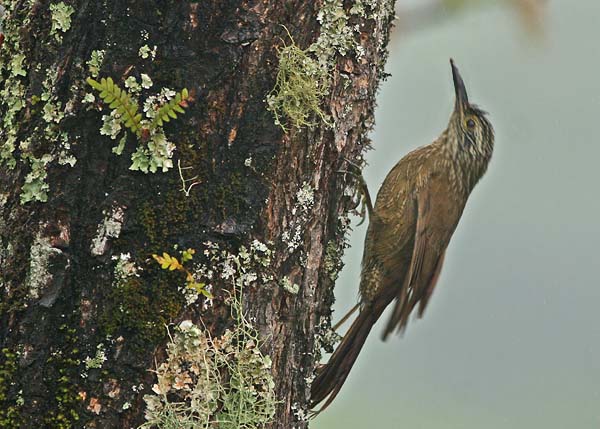 The
Woodcreepers are a largish set (over 50 species) of Neotropical
suboscine passerines. Once upon a time they were called "woodhewers,"
meaning "little woodpeckers" in local lingo, but woodcreepers rarely
hammer at tree trunks like woodpeckers. "Woodcreepers" is a much better
name, more accurately reflecting what they generally do: forage on the
trunks and large branches of trees by probing bark, crevices, and
bromeliads (Marantz et al. 2003). They have have more or less the same
basic shape and are easy to recognize as a group. This Planalto Woodcreeper
(left) from southeastern Brazil is an example. However, although a
woodcreeper is easy to recognize as such, separating the species from
each other is a much more difficult task.
The
Woodcreepers are a largish set (over 50 species) of Neotropical
suboscine passerines. Once upon a time they were called "woodhewers,"
meaning "little woodpeckers" in local lingo, but woodcreepers rarely
hammer at tree trunks like woodpeckers. "Woodcreepers" is a much better
name, more accurately reflecting what they generally do: forage on the
trunks and large branches of trees by probing bark, crevices, and
bromeliads (Marantz et al. 2003). They have have more or less the same
basic shape and are easy to recognize as a group. This Planalto Woodcreeper
(left) from southeastern Brazil is an example. However, although a
woodcreeper is easy to recognize as such, separating the species from
each other is a much more difficult task. 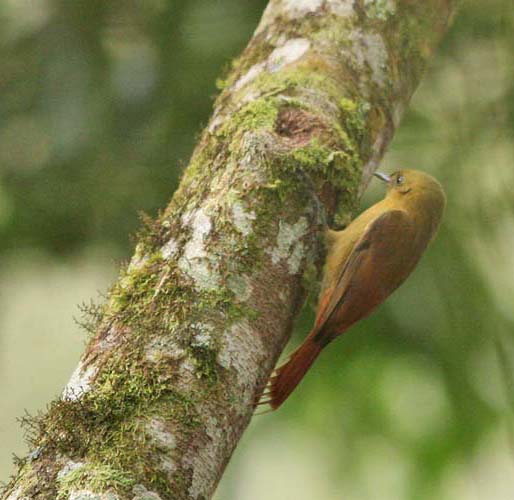
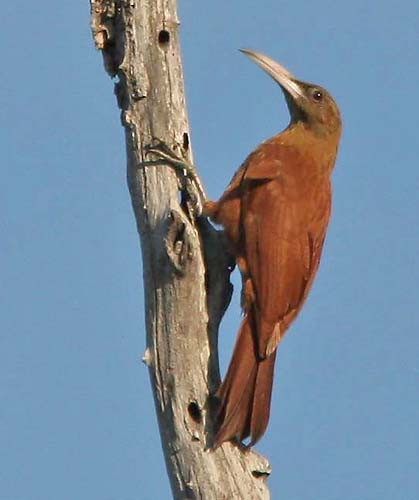
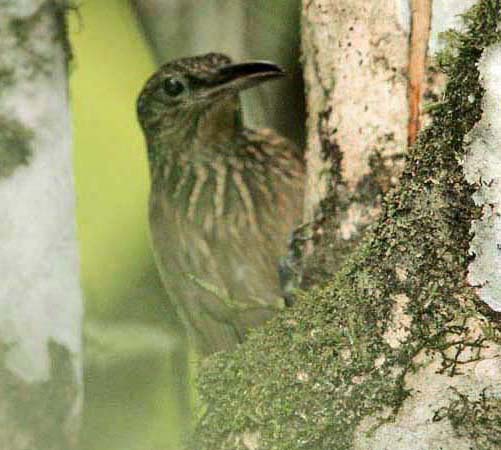

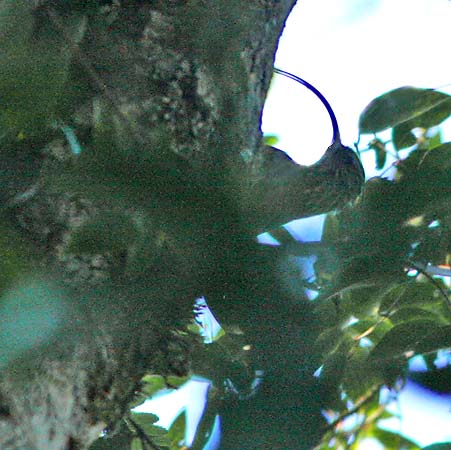 The most dramatic bills among the woodcreepers are carried by the five species of scythebills (genus Campylorhamphus). This distant shot in the canopy is of Black-billed Scythebill
(right), a species restricted to southeast Brazil and northeast
Argentina. These bills are used to delicately probe for insects and
larvae. Any scythebill is a birder's treat, and some are quite limited
and patchy in distribution, such as Greater Scythebill C. pucherani of subtropical forests in the Andes. A number of scythebills have haunting cries, and are best found by these vocalizations.
The most dramatic bills among the woodcreepers are carried by the five species of scythebills (genus Campylorhamphus). This distant shot in the canopy is of Black-billed Scythebill
(right), a species restricted to southeast Brazil and northeast
Argentina. These bills are used to delicately probe for insects and
larvae. Any scythebill is a birder's treat, and some are quite limited
and patchy in distribution, such as Greater Scythebill C. pucherani of subtropical forests in the Andes. A number of scythebills have haunting cries, and are best found by these vocalizations. 
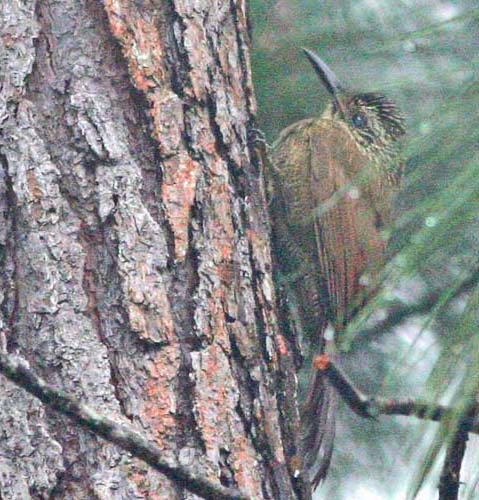
 There
is an subset of woodcreepers that do not forage widely within the
forest canopy but, instead, follow army ants across the jungle floor,
sitting on stems and branches around the ant swarms in the undergrowth,
and snatching up prey disturbed by them. White-chinned Woodcreeper Dendrocincla merula , both Northern Barred Dendrocolaptes sanctithomae and Southern Barred D. certhis woodcreepers, and two species in genus Xylexetastes, Red-billed X. perrotii and Bar-bellied X. stresemanni,
are obligate ant followers. The dark plumage, contrasting with the blue
bare-skin eye-rings of the latter two species, make them look
wonderfully 'blue-eyed' in the dark of the forest interior.
There
is an subset of woodcreepers that do not forage widely within the
forest canopy but, instead, follow army ants across the jungle floor,
sitting on stems and branches around the ant swarms in the undergrowth,
and snatching up prey disturbed by them. White-chinned Woodcreeper Dendrocincla merula , both Northern Barred Dendrocolaptes sanctithomae and Southern Barred D. certhis woodcreepers, and two species in genus Xylexetastes, Red-billed X. perrotii and Bar-bellied X. stresemanni,
are obligate ant followers. The dark plumage, contrasting with the blue
bare-skin eye-rings of the latter two species, make them look
wonderfully 'blue-eyed' in the dark of the forest interior.